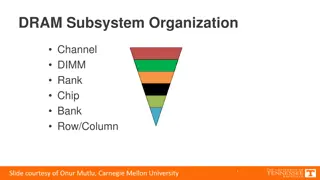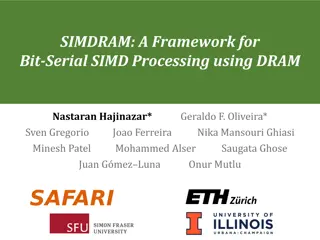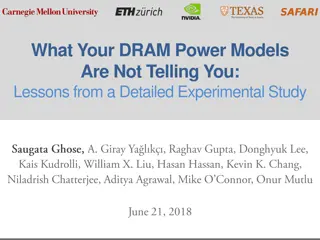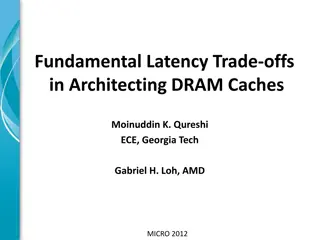Quick Evaluation of Physical Unclonable Functions in DRAM Devices
Leveraging the latency-reliability tradeoff in commodity DRAM devices, this study presents a novel approach to quickly evaluate Physical Unclonable Functions (PUFs) in modern DRAM technology. The research explores the unique characteristics of DRAM latency failures and proposes a method to generate PUF responses using latency errors. Key observations and results highlight the efficacy of the DRAM Latency PUF approach in generating unique device signatures efficiently.
Download Presentation

Please find below an Image/Link to download the presentation.
The content on the website is provided AS IS for your information and personal use only. It may not be sold, licensed, or shared on other websites without obtaining consent from the author.If you encounter any issues during the download, it is possible that the publisher has removed the file from their server.
You are allowed to download the files provided on this website for personal or commercial use, subject to the condition that they are used lawfully. All files are the property of their respective owners.
The content on the website is provided AS IS for your information and personal use only. It may not be sold, licensed, or shared on other websites without obtaining consent from the author.
E N D
Presentation Transcript
The DRAM Latency PUF: Quickly Evaluating Physical Unclonable Functions by Exploiting the Latency-Reliability Tradeoff in Modern Commodity DRAM Devices Jeremie S. Kim Minesh Patel Hasan Hassan Onur Mutlu
Motivation A PUF is function that generates a signature unique to a given device Used in a Challenge-Response Protocol - Each device generates a unique PUF response depending the inputs - A trusted server authenticates a device if it generates the expected PUF response 2/8
DRAM Latency Characterization of 223 LPDDR4 DRAM Devices Latency failures come from accessing DRAM with reduced timing parameters. Key Observations: 1. A cell s latency failure probability is determined by random process variation 2. They are repeatable and unique to a device 3/8
DRAM Latency PUF Key Idea High % chance to fail with reduced tRCD Low % chance to fail with reduced tRCD Row Decoder SA SA SA SA SA SA SA 4/8
DRAM Accesses and Failures wordline access transistor Vdd Vmin Ready to Access Voltage Level Bitline Voltage bitline Process variation during manufacturing capacitor Bitline Charge Sharing SA leads to cells having unique characteristics 0.5 Vdd Time ACTIVATE SA Enable READ tRCD 5/8
DRAM Accesses and Failures wordline access transistor Vdd Vmin Ready to Access Voltage Level Bitline Voltage bitline weaker cells have a higher probability to fail capacitor SA 0.5 Vdd Time ACTIVATE SA Enable READ tRCD 6/8
The DRAM Latency PUF Evaluation We generate PUF responses using latency errors in a region of DRAM The latency error patterns satisfy PUF requirements The DRAM Latency PUF generates PUF responses in 88.2ms 7/8
Results We are orders of magnitude faster than prior DRAM PUFs! 8/8
The DRAM Latency PUF: Quickly Evaluating Physical Unclonable Functions by Exploiting the Latency-Reliability Tradeoff in Modern Commodity DRAM Devices Jeremie S. Kim Minesh Patel Hasan Hassan Onur Mutlu QR Code for the paper https://people.inf.ethz.ch/omutlu/pub/dram-latency-puf_hpca18.pdf






















